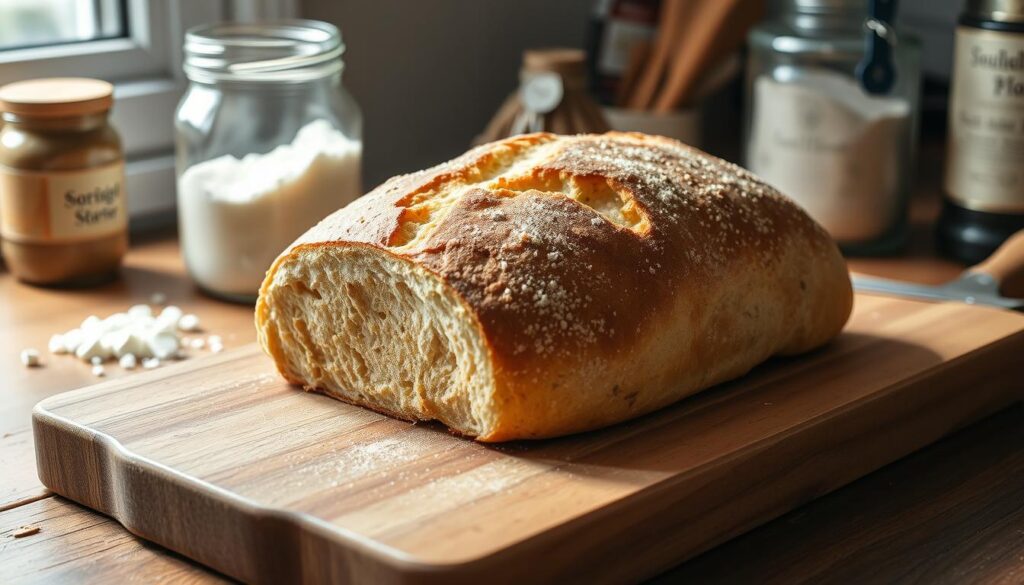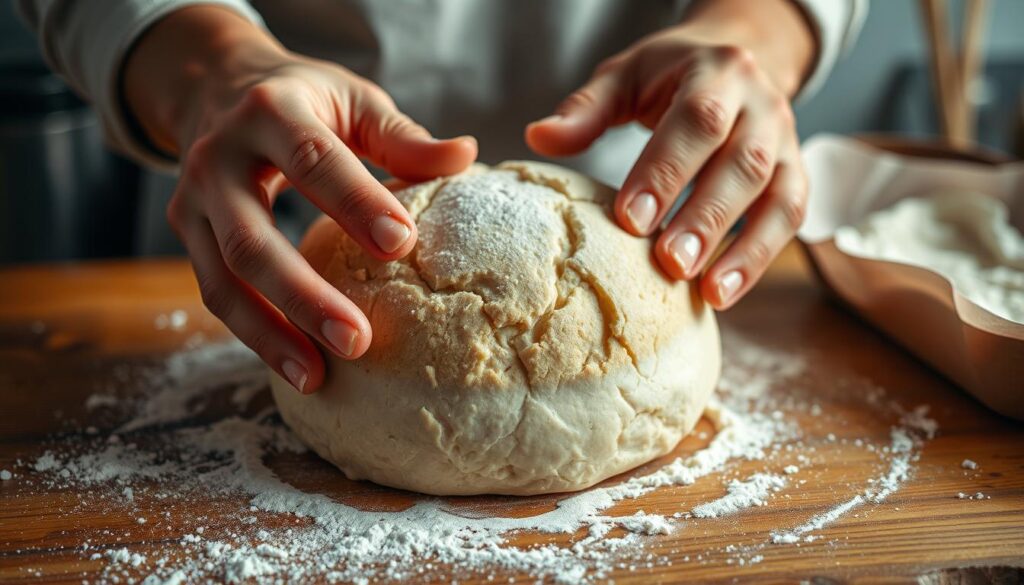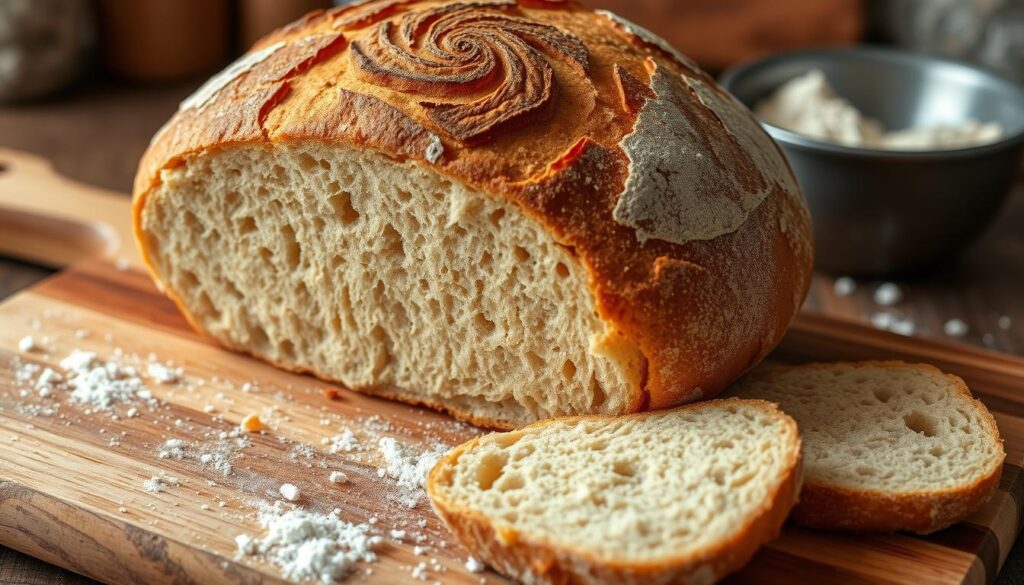Learn how to make a delicious homemade sourdough bread perfect for sandwiches. This guide will show you how to create a crusty, flavorful loaf. It’s great for impressing your loved ones, whether you’re new to sourdough or experienced.

Table of Contents
Unlocking the Secrets of Sourdough Bread
Sourdough bread is special, unlike commercial yeasted breads. It has a unique flavor and texture from sourdough fermentation. The sourdough starter, a mix of wild yeasts and bacteria, gives it its distinct taste.
The Allure of Homemade Sourdough
Making homemade sourdough bread is a labor of love. It needs patience and a good understanding of fermentation. The result is a chewy crumb, a crisp crust, and a tangy flavor.
By baking your own homemade sourdough, you can choose your ingredients and flavors. You also get to enjoy the pride of making an artisanal loaf from scratch.
Understanding Sourdough Starters
- A sourdough starter is a mix of wild yeasts and bacteria. They ferment the dough, creating sourdough’s unique taste and texture.
- Keeping a healthy sourdough starter is key for great bread. You need to feed it regularly with flour and water to keep it alive.
- The sourdough fermentation process is slow. Wild yeasts and bacteria turn the dough’s starches and sugars into carbon dioxide and lactic acid. This creates the bread’s special flavor.
To master sourdough bread, you must understand the sourdough starter and sourdough fermentation. With these skills, you can make homemade sourdough loaves that stand out.
“Sourdough bread is not just a food, it’s a way of life. The time and care you put into your starter and dough is evident in every bite.”
Ingredients for Delicious Sandwich Sourdough Bread
Making the perfect sandwich sourdough bread needs the right mix of ingredients. High-quality flour and a mature sourdough starter are key. Each part is crucial for a balanced loaf. Let’s look at what you need to bake a tasty sandwich sourdough bread at home.
Flour Power
The flour is the base of sourdough bread. While all-purpose flour works, mixing bread flour and whole wheat flour makes it better. Bread flour gives structure and rise, while whole wheat adds a nutty flavor.
Water, the Elixir of Life
Water is essential in sourdough recipes. The right amount of water changes the bread’s texture. It can be dense or light, depending on the starter’s hydration level.
The Seasoning Essentials
Salt and sugar are important for flavor. Salt enhances taste and controls fermentation. Sugar feeds yeast for a golden crust.
The Heart of the Matter: Sourdough Starter
A mature sourdough starter is the bread’s heart. It gives sourdough its tangy flavor and chewy texture. Using the right starter amount is key for a great rise and crumb.
| Ingredient | Quantity |
|---|---|
| Bread Flour | 500g |
| Whole Wheat Flour | 100g |
| Water | 375ml |
| Salt | 10g |
| Sourdough Starter | 100g |
With these ingredients, you’re ready to make a delicious sandwich sourdough bread. It will impress everyone with its taste and texture.
Sourdough Sandwich Bread Recipe (Easy beginner version!)
Easy and Exciting Cottage Cheese Recipes: Transform Your Snack Game
Step-by-Step Guide to Making Sandwich Sourdough Bread Recipe
Are you ready to make sourdough bread? Let’s start with the sourdough starter and mixing the dough. This guide will help you bake perfect homemade sourdough bread.
Preparing the Sourdough Starter
A healthy sourdough starter is key for great bread. To keep it alive, feed it regularly. Here’s how:
- Feed your sourdough starter with equal parts flour and water, stirring well to combine.
- Cover the starter and let it sit at room temperature for 8-12 hours, or until it has doubled in size and is bubbly.
- Discard a portion of the starter, then repeat the feeding process until the starter is consistently rising and falling in a predictable pattern.
Mixing the Dough
Now, let’s mix the dough for your sandwich loaf. Here’s how:
- In a large bowl, combine the sourdough starter, flour, water, and salt. Knead the mixture until a smooth, elastic dough forms.
- Cover the dough and let it rise for 8-12 hours, or until it has doubled in size.
- Punch down the dough to release any air bubbles, then shape it into a loaf and place it in a greased bread pan.
By following these steps, you’ll be well on your way to creating a delicious and nutritious sandwich sourdough bread. Stay tuned for the next section, where we’ll cover shaping and proofing your sourdough loaf.
Shaping and Proofing Your Sourdough Loaf
Shaping and proofing your sourdough bread is key in baking. It gives your loaf its shape and lets it rise. This step also helps develop its complex flavors. Let’s explore this important phase.
Shaping the Dough
First, your sourdough dough needs to rise. Then, shape it into a beautiful loaf. Start by gently pressing out air pockets. Next, shape the dough into a tight ball by folding it over itself a few times.
For a classic shape, stretch and roll the dough into a rectangle. Make sure the top is smooth. Place the dough in a greased loaf pan, seam-side down.
Proofing the Loaf
Now, let your dough rise again, called proofing. This step is vital for the sourdough’s texture and flavor. Place the loaf in a warm, draft-free spot for 2-3 hours. It should look bigger and feel light.
To check if it’s ready, press your finger into the dough. If it springs back, it’s time to bake. But don’t let it over-proof, or it will be dense.
| Shaping Sourdough Bread | Proofing Sourdough Bread |
|---|---|
| Gently degas the dough to release large air pockets | Allow the shaped loaf to rise for 2-3 hours in a warm, draft-free environment |
| Shape the dough into a tight, smooth ball | Test for readiness by gently pressing your finger into the surface |
| For a sandwich loaf, stretch and roll the dough into a rectangular shape | Avoid over-proofing, as this can lead to a dense, flat crumb |
Mastering shaping and proofing will help you bake a delicious sourdough loaf. It will be beautifully risen and full of flavor.

Baking Your Sandwich Sourdough Bread to Perfection
Getting your sourdough loaf just right is the goal of your baking journey. With some expert tips, you can make a sourdough crust that’s golden, crisp, and tempting. Let’s explore the secrets to baking sourdough bread perfectly.
Achieving the Perfect Sourdough Crust
The secret to a stunning sourdough crust is in the baking. Here are some tips to help you get it right:
- Preheat your oven to a high temperature, around 450°F (230°C), to ensure your loaf gets a strong initial rise and develops a gorgeous crust.
- Use a Dutch oven or a baking stone to create a steam-rich environment, which is crucial for achieving that signature sourdough crust. The steam helps the bread expand and creates a crisp outer layer.
- Brush the top of your loaf with water or an egg wash just before baking to further enhance the crust’s appearance and texture.
- Bake your sourdough for 20-25 minutes with the lid on, then remove the lid and bake for an additional 15-20 minutes to allow the crust to deepen in color and develop a satisfying crunch.
By following these simple steps, you’ll be well on your way to creating a sourdough loaf with a perfectly baked crust. Your friends and family will be impressed by your baking skills.
“The secret to a great sourdough crust is all in the baking process. With a few key techniques, you can unlock the bakery-worthy crust of your dreams.”
Tips for Storing and Enjoying Your Sandwich Sourdough Bread
Keeping your homemade sandwich sourdough bread fresh and flavorful is key. A few simple tips can help your bread stay delicious for days. Learning how to use this artisanal bread in your meals opens up new culinary possibilities.
Storing Sourdough Bread for Maximum Freshness
After your sourdough loaf cools, the secret to storing sourdough bread is to keep it dry. Use a paper bag, cloth bag, or bread box at room temperature. Plastic bags trap moisture, leading to staling. Properly stored, your sourdough bread shelf life can last up to 5 days.
Reviving Stale Sourdough Bread
When your sourdough bread gets stale, you can revive it. Just sprinkle it with water and bake in a 300°F oven for 5-10 minutes. This will make the crust soft and the inside moist, like it’s just baked.
Enjoying Sourdough Bread in Delicious Recipes
There are many ways to how to enjoy sourdough bread. Try it toasted with your favorite toppings or in sandwiches. It’s also great for bruschetta, French toast, or croutons. The tangy, chewy texture complements both sweet and savory flavors.
| Storage Method | Sourdough Bread Shelf Life |
|---|---|
| Paper Bag | Up to 5 days |
| Cloth Bag | Up to 5 days |
| Bread Box | Up to 5 days |
| Plastic Bag | 3-4 days |
By following these tips, you can enjoy your homemade sourdough bread for longer. With a little care and creativity, you’ll savor its unique flavors for days.

Sandwich Sourdough Bread Recipe Variations
Try new things with your sandwich sourdough bread. You can make it savory or sweet by adding different mix-ins. Get creative and make sourdough breads that taste amazing.
Adding Flavorful Mix-Ins
Try adding different ingredients to your sourdough bread. Use herbs like rosemary, thyme, or oregano for a rustic taste. Add crumbled feta or shredded cheddar for a savory twist. Dried fruits like cranberries or apricots can add sweetness.
For a denser bread, add chopped nuts, seeds, or cooked bacon bits. You can choose what you like best, making it perfect for you.
| Mix-In Ingredient | Quantity | Taste Profile |
|---|---|---|
| Dried Rosemary | 2 tablespoons | Earthy and Fragrant |
| Crumbled Feta Cheese | 1 cup | Salty and Tangy |
| Dried Cranberries | 3/4 cup | Sweet and Tart |
| Chopped Walnuts | 1/2 cup | Crunchy and Nutty |
By trying different mix-ins, you can make a sourdough bread that’s truly special. It will wow your family and friends. Enjoy exploring the world of sourdough variations.
The Benefits of Homemade Sandwich Sourdough Bread
Baking your own sandwich sourdough bread at home brings many advantages. It tastes great and is better for you than store-bought bread. It’s more nutritious and easier to digest.
One big plus of homemade sourdough is how well it digests. The fermentation process breaks down gluten and carbs. This makes the bread gentler on your stomach. It’s good for those with gluten sensitivities or who want a healthier option.
Also, homemade sourdough is packed with more nutrients. It has more vitamins, minerals, and antioxidants. This is because the longer fermentation process unlocks these nutrients. It makes the bread even healthier.
FAQ
What is the difference between a sourdough starter and regular yeast?
A sourdough starter uses wild yeast and bacteria for leavening. Regular yeast is a single strain. Sourdough starters give bread a complex flavor and a chewier texture.
How do I maintain and feed my sourdough starter?
To keep your sourdough starter alive, discard some and add fresh flour and water every 12-24 hours. This keeps it active and healthy. The feeding schedule depends on your environment’s temperature and the starter’s activity.
How long does it take to make a loaf of homemade sourdough bread?
Making sourdough bread takes 8-24 hours. This includes feeding the starter, mixing, fermentation, shaping, and baking. Longer time develops the bread’s flavors.
Can I use all-purpose flour to make sourdough bread?
Yes, you can use all-purpose flour for sourdough. But mixing it with bread flour or whole wheat flour is better. This creates a chewier crumb.
How do I achieve a crispy crust on my homemade sourdough bread?
For a crispy crust, bake at 450°F for 20-25 minutes. Use a baking stone or Dutch oven for steam. Brush with water or egg wash before baking.
How long does homemade sourdough bread last?
Homemade sourdough bread lasts 3-5 days at room temperature. Store it in a paper bag or linen. Avoid plastic to keep the crust crisp. Freeze for up to 3 months for longer storage.
Can I add mix-ins to my sourdough bread?
Yes, adding mix-ins like herbs, cheeses, or dried fruit makes sourdough unique. Just adjust the dough’s hydration for the added ingredients.
